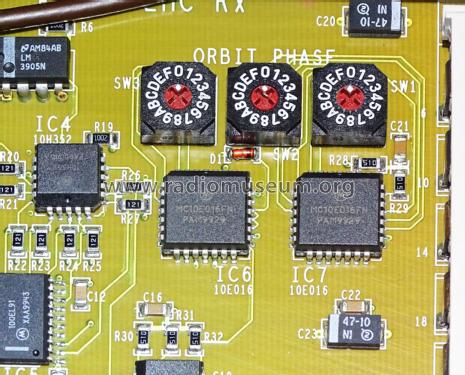LHCrx Receiver 1142-550
Unknown - CUSTOM BUILT: Switzerland (CH)
- País
- Suiza
- Fabricante / Marca
- Unknown - CUSTOM BUILT: Switzerland (CH)
- Año
- 1999
- Categoría
- Signal Processing and Computing
- Radiomuseum.org ID
- 358359
- Numero de transistores
- Hay semiconductores.
- Semiconductores
- Gama de ondas
- - no hay
- Tensión de funcionamiento
- Alimentado desde otro equipo o aparato principal. / DC: 5 & -2 & -5.2 Volt
- Altavoz
- - - No hay salida de sonido.
- Material
- Metálico
- de Radiomuseum.org
- Modelo: LHCrx Receiver 1142-550 - Unknown - CUSTOM BUILT:
- Forma
- Chasis (tambien de autoradio)
- Ancho, altura, profundidad
- 50.6 x 129 x 193 mm / 2 x 5.1 x 7.6 inch
- Anotaciones
-
TTCex and TTCtx laser transmitters are used primarily for the optical transmission of Timing, Trigger and Control (TTC) signals to many thousands of destinations in the front-end electronics of high-energy particle physics experiments at CERN's Large Hadron Collider (LHC). In addition to broadcasting the 40.08 MHz LHC bunch-crossing clock, at each experiment the system transmits a low-latency A channel for the Level-1 trigger-accept and a B channel for broadcast and individually-addressed commands and data.
Initially, the same transmitters were also used for broadcasting the bunch-crossing clock from the control centre to each of the physics experiment areas around the 26.66 km LHC ring. The optical signals were received and decoded by 1142-550 LHCrx Receiver modules. Since there is no trigger-accept in this application, the A channel was used for transmitting the 11.2455 kHz LHC Orbit signal to the experiments. As in the main front-end electronics application, the signals are received in the LHCrx by a TRR-1B43 optoelectronic receiver coupled to a custom CMOS receiver ASIC. In the LHCrx, the ASIC is mounted on a 100-pin mezzanine board inside the module. The clock output from the LHCrx is an AC-coupled square-wave ECL signal that is cleaned up by a separate 1142-300 VCXO-PLL unit before being distributed to the local TTC system of the experiment. The LHCrx uses 5 V, -2 V and -5.2 V power supplies for its ECL logic and is housed in a standard 3TU 10HP Europa cassette.
The ideal optical input signal level for the LHCrx is about -20 dBm. The internal PLL may lose lock below -33 dBm, while overloading begins above -5 dBm. A green 'Ready' LED on the front panel indicates when the module is phase locked to the incoming signal, and a phaselock watchdog circuit ensures that the LHCrx PLL will automatically relock when the incoming signal is restored after any interruption. An MO optoelectronic receiver is incorporated for monitoring the incoming signal or the outgoing signals from any of the local laser transmitters. The red 'CD' LED is a carrier detect indicator and the ECL swing output from the receiver is AC coupled and can drive a 50 Ω load.
To compensate for differences in fibre optic cable lengths and particle times of flight, programmable deskew circuits in the front-end electronics provide for phase shifting the commands and local Level-1 trigger signal by up to 16 clock cycles in steps of 104 ps. The LHC Orbit signal broadcast from the control centre has an arbitrary but invariable phase relative to the structure of the circulating beams. To compensate for the phase differences in the Orbit signal received at different locations around the LHC ring, the LHCrx incorporates a digital phase adjustment which allows the phase of the signal to be set throughout the 88.924 μs period in 3564 steps of the bunch crossing interval of about 25 ns. For compatibility with associated equipment the Orbit output is a DC-coupled ECL negative-going 1μs pulse train. There are three rotary Orbit phase adjustment switches in the module. The least significant switch SW1 adds delay in steps of the 25 ns bunch period. Each step of SW2 corresponds to a full rotation of SW1 (400 ns) and each step of the most significant switch SW3 to a full rotation of SW2 (6.4 μs). Once the Orbit phase switches have been set for the experiment location they do not require adjustment again.
The 1142-550 LHCrx was designed by Bruce Taylor and manufactured from 1999.
- Peso neto
- 0.528 kg / 1 lb 2.6 oz (1.163 lb)
- Mencionado en
- -- Original-techn. papers. (User manual)
- Autor
- Modelo creado por Bruce Taylor. Ver en "Modificar Ficha" los participantes posteriores.
- Otros modelos
-
Donde encontrará 32 modelos, 30 con imágenes y 3 con esquemas.
Ir al listado general de Unknown - CUSTOM BUILT: Switzerland (CH)
Colecciones
El modelo LHCrx Receiver es parte de las colecciones de los siguientes miembros.





